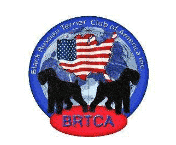The Black Russian Terrier is a very young breed, having been recognized as a separate breed in Russia in 1981 and three years later in 1984 accepted in FCI. In the United States, the Black Russian Terrier was accepted by AKC into the Miscellaneous Class in 2001, and fully accepted into the Working Group in 2004. But how did the Black Russian Terrier come to be?
Prior to World War II, the Russian army had over 40,000 working dogs with 168 separate units that participated in battles. After World War II, dogs suitable for service work had become essentially extinct, and the government ordered the creation of a new breed that would be able to serve as a multi-purpose military dog in different climatic regions.
In the mid 1940’s, the Central School of Military Breeding (A Red Star Kennel@) undertook this task, mass cross-breeding from the few serviceable breeds available post-war. It is believed that at least 17 breeds and cross-breeds were used in the Red Star Kennel breeding program which eventually produced the Black Russian Terrier recognized by the Russian Ministry of Agriculture as a breed in 1981.
Some of the breeds used were the Giant Schnauzer, Rottweiler, Airedale Terrier, South Russian and Central Asian Ovcharka, Newfoundland, Great Dane and Moscow Diver (now extinct) among others. The Red Star Kennel geneticists evaluated many aspects of what was being produced in determining which characteristics should be maintained and which should be discarded. As one can imagine, with such a varied genetic background of different breeds and cross-breeds, and without the use of genetic and other diagnostic tools we enjoy today, this was a huge undertaking evolving over many decades!
A Giant Schnauzer named “Roy” is credited as being the foundation sire of the Black Russian Terrier. Roy produced large black dogs with rough coat on the head and legs when crossed with certain females of different breeds. While there were certainly other colors that were produced during the formative years and which can also still appear from time to time in litters even now, there were other reasons why the Russian geneticists chose to further develop the black coated dogs.
The goal of the Red Star Army was to basically produce a multi-purpose military dog. This dog had to work closely with its handler, over different terrain and varying climates, whether on patrol, guarding, or drafting. Not only was correct size and structure required, temperament and trainability were equally important.
Why Black?
It is not unusual from time to time for puppies in a litter to have coats with “throw-back” colors and patterns which can include black and tan, black and silver, sable, gray, fawn and shades in between. Historically these pups were eliminated from any breeding program. Now, genetic color testing is available to determine what color gene a dog is carrying so that breeders can make intelligent choices with regard to maintaining the black in the Black Russian Terrier. Color testing is now one of the required tests for Black Russian Terriers to obtain a CHIC number.
Black dogs require dark pigmentation of the nose, eyes, gums and lips. As the breed stabilized and consistently reproduced itself, the black dogs from the “Roy” (Giant Schnauzer) line consistently exhibited the qualities that were being sought. Remembering that there was no such thing as DNA testing post-WWII, the geneticists noticed a correlation between black dogs with maximum pigmentation and a sound temperament in comparison to light pigmented, non-black dogs.
According to canine Russian expert Dr. Eugene Yerusalimsky (world known dog expert, international judge, author of Russian and FCI breed standards, author and international lecturer on canine biomechanics), in a letter written to the Black Russian Terrier Club of America in May 2016 in response to the emergent issue of the United Kennel Club registry considering a standard change to allow coat colors other than black, he states:
“For the black color, the standard requires maximum pigmentation of the coat, nose, eyelids, eyes, gums and lips. This is because the direct selection for maximum pigmentation is an indirect selection for both a strong nervous system and a stable temperament.”
The geneticists found there was a correlation between temperament and color in the Black Russian Terrier; and from the very first standard for the breed promulgated in 1956 to date, the only acceptable color for the Black Russian Terrier is BLACK.
Dr. Yerusalimsky also noted that:
“During the first few generations of Black Russian Terriers, the dogs quite often could have hyper excitability and unmotivated aggression. Being large, such dogs were socially very dangerous, and because of that they were consistently eliminated from the breeding program of the breed. As a result of this selection, the temperament of contemporary Black Russian Terriers began to meet all the modern requirements of social living.”
This is a very important statement. What were these dogs that possessed such “hyper-excitability,” “unmotivated aggression” and were “socially very dangerous” to the extent that they had to be “eliminated from the breeding program of the breed”? Two breeds mentioned by Dr. Yerusalimsky are the black and tan Rottweiler and the black and tan Airedale Terrier.
In discussing the specific black and tan markings reminiscent of the Rottweiler, he states:
“As one of the ancestors of the BRT, the Rottweiler also has to have maximum pigmentation, a strong nervous system and a stable temperament. However, because the original intention of the breed was to be essentially a butcher’s guard dog, the Rottweiler is more aggressive than the Giant Schnauzer, who is in [sic] usually more of a companion dog. Thus, the interbreed type of Black Russian Terriers, which is tilted towards the Giant Schnauzer, is more socially acceptable.”
G. A. Yatcenko, the President of the National Russian Black Terrier Club, and M. V. Gerasimova, then President of the International Black Russian Terrier Club, provided additional information regarding non-black coated dogs in May and June 2016. Prior to 2006, puppies not black in color received registration cards with the notation “not acceptable for breeding” and “the color is not accepted by the FCI.” In 2006 such breedings were discontinued “by verdict of the Breeding Commission of the RKF.”
This allowed breeders an opportunity to test breed over time and to analyze, via bloodlines, the possibility of planned breeding of black and tan dogs. Ms. Gerasimova stated that:
“We can note that black-and-tan dogs were a good type of dog
and very close to the standard BRT in build and coat. However, they were often overly aggressive. Saddle dogs were very close in build to the Airedale and had an explosive temperament, were overly reactive and difficult to manage, all which does not correspond with the BRT standard.”
As our many years of experience show, pigmentation is closely linked with the stability of the nervous system. This is why it is necessary to select for reinforcing the pigmentation of the eyes, gums and coat. Black dogs most closely align with our image of the desirable Black Russian Terrier—based on their type, their exterior, their temperament and their working abilities.
Dr. Yerusalimsky also addressed the undesirable color-temperament link inherited from the Airedale Terrier.
This hyper-excitability, in combination with the large size, presents a danger in keeping a BRT, and this is one of the exact reasons why the experimental breeding of Black Russian Terriers using black and tan dogs, which started in Russia about 10 years ago, was discontinued…by verdict of the Breeding Commission of the RKF.
It was quickly recognized within the early generations of the breeding program that certain color traits were linked with temperament; and it was necessary to eliminate those colors that were producing these large dogs which exhibited unmotivated aggression, hyper-excitability, and therefor deemed “socially very dangerous.” The black dogs, on the other hand, did not possess these undesirable traits and thus remained in the breeding program. As Ms. Gerasimova noted, these same undesirable traits were also noted in the test breedings done prior to 2006.
Every registry around the world recognizes that the only acceptable color for a Black Russian Terrier is BLACK except for a for-profit organization known as the United Kennel Club, a for-profit corporation (UKC), which, at the request of a few, changed its standard in 2016 to allow dogs other than black to be registered and to compete in conformation shows and to obtain a “Champion” title under its registry. This change to their registry standard was carried out despite strong objections from the Black Russian Terrier Club of America, the Russian Kynological Federation (RKF), and the International Black Russian Terrier Club.
There are a few breeders in the United States and other parts of the world who are purposefully breeding to produce Black Russian Terriers that are NOT black, most of which appear to be black and tan. Their reasons for doing so are self-serving. Yes, these coats may be quite beautiful, but as the saying goes, beauty is only skin (or coat) deep.
A pretty coat does not mean that it lies on a properly structured dog, or that the dog’s temperament will not be as the above experts observed and reported. It might not be the first generation that the temperament issue arises (as the genes from the black pigment override), but as future breedings occur, this will change as it did in the Russian experiment. Purposefully breeding to produce coat color other than black is a huge disservice to the breed and affects future generations as undesirable genes are introduced into a small gene pool.
Can a Black Russian Terrier that is a color other than black be registered through the American Kennel Club? Yes, if its parents were properly registered as it would still be a purebred dog. However, it would be disqualified if entered in an AKC or FCI show because any color other than black is a disqualification. Being registered does not equal quality. No reputable registry in the world will allow a Black Russian Terrier to exhibit; much less obtain a championship, which does not have a BLACK coat. No other color is acceptable. Any Black Russian Terrier being advertised as a UKC “champion” that is not black is akin to a mail order diploma.
It is a disservice to the future of the Black Russian Terrier to purposefully breed for any color other than black. It is a disservice and unethical to cross-breed with any other breed. Be wary of any “breeder” who markets such dogs as being “unique” and “special” and of “champion” quality.
Why Are Black Russian Terriers Black? – From the March 2018 issue of Showsight Magazine.
Are you looking for a Black Russian Terrier puppy?
The best way to ensure a long and happy relationship with a purebred dog is to purchase one from a responsible breeder. Not sure where to begin finding a breeder? Contact the National Parent Club’s Breeder Referral person, which you can find on the AKC Breeder Referral Contacts page.
Want to help rescue and re-home a Black Russian Terrier dog?
Did you know nearly every recognized AKC purebred has a dedicated rescue group? Find your new best friend on the AKC Rescue Network Listing.
Black Russian Terrier Dog Breed Magazine
Showsight Magazine is the only publication to offer dedicated Digital Breed Magazines for ALL recognized AKC Breeds.
Read and learn more about the charming Black Russian Terrier dog breed with articles and information in our Black Russian Terrier Dog Breed Magazine.
Error embedding FlippingBook shortcode, please check the flipbook url. (https://digital.showsightmagazine.com/view/449844/)









